ASSOCIATION OF VINEYARD CHURCHES TIMELINE
1934 (February 25): John Wimber was born in Kirksville, Missouri or Peoria, Illinois.
c1940: Wimber received his first saxophone.
c1946: Wimber and his mother moved to California.
1949: Wimber made his first professional appearance.
1955: Wimber met his future wife, Carol, a member of The Paramours, her prom band. The couple was married seven months later. The Paramours would work the Las Vegas circuit for the next five years. Wimber (as Johnny Wimber) played keyboards.
1960: The Wimbers faced a marriage crisis and separated. The separation ended when each cried out to God for help. The couple remarried in the Roman Catholic Church. They also attended a Friends Meeting and Bible studies. Carol began Bible studies in their home.
1962: The Wimbers recruited Bobby Hatfield and Bill Medley for The Paramours. The group later became The Righteous Brothers, originally with Wimber on keyboards.
1962: Through Paramours‘ drummer Dick Heyling, the Wimbers met Quaker lay evangelist Gunner Payne and began attending Payne’s Bible studies at Heyling’s home.
1963: John and Carol Wimber had near-simultaneous conversion experiences at one of Payne’s Bible studies. The Wimbers continued leadership involvement with Bible study groups through the Friends Meeting, with Gunner Payne at the Heylings, and in their own home, beginning a period of intense evangelism.
c1967: John Wimber felt called to leave the music business and enrolled in Azusa Pacific University to study the Bible for three years.
1970: Upon graduation, Wimber was “registered” (ordained) by Society of Friends. He became assistant pastor of Yorba Linda Friends meeting and continued to lead a number of Bible studies which became increasingly intense and well attended. They came to the attention of the Southern California religious community.
1974: John and Carol Wimber and forty of their Bible study students were asked to leave the Friends Meeting. John was invited by C. Peter Wagner to help found the new Fuller Institute for Church Growth.
1975-1978: Wimber taught church growth and planting as an adjunct faculty at Fuller while continuing to lead growing Bible studies.
1977: Bible studies grew and were incorporated as a congregation of Calvary Chapel.
1979: Wimber met Ken Gullicksen, another member of the Calvary Chapel movement, at a retreat.
1980: Lonnie Frisbee preached to Wimber’s congregation on Mother’s Day, triggering an outpouring of charismatic phenomena.
1982-1986: Wimber and Wagner taught a Signs, Wonders, and Church Growth course at Fuller.
1982: Wimber broke with Calvary Chapel over Wimber’s increasing emphasis on charismatic phenomena, and, with several other Calvary Chapel groups, joined with Gullicksen’s group of Vineyard churches. Gullicksen asked Wimber to take the lead.
1982: Vineyard Christian Fellowship of Anaheim was incorporated.
1984: Vineyard Ministries International was established.
1985: The Association of Vineyard Churches incorporated. Mercy Music (later Vineyard Music) was established.
1986: Wimber published his book Power Evangelism.
1986: Wimber suffered a heart attack.
1988: Wimber established close relationships with prophetic figures of the Kansas City Fellowship (which was renamed The Kansas City Vineyard).
1991: Wimber became disillusioned with the Kansas City “prophets” and broke off the relationship.
1994: The “Toronto Blessing” revival broke out at Toronto Airport Vineyard Church. It drew international attention to extreme charismatic phenomena.
1993-1995: Wimber received cancer diagnosis and suffered a stroke.
1995: Wimber observed the “Toronto Blessing” revival and cuts ties with it.
1997 (July): Wimber installed Todd Hunter as National Coordinator of The Association of Vineyard Churches.
1997 (November): Wimber died of massive brain hemorrhage.
2000: Hunter resigned his position. The board named Bert Waggoner of Sugarland, Texas, to succeed him.
2011: Waggoner retired and was replaced by Phil Strout of Maine.
FOUNDER/GROUP HISTORY
The Association of Vineyard Churches (or the Vineyard movement) grew out of the Jesus movement that developed within the “hippie” culture of Southern California in the 1960s. This movement was built more around gifted evangelists working mostly through home-based Bible study groups rather than through established churches. Many of these groups involved music scene figures, some of whom were fairly prominent.
Three of those evangelists who were exceptionally successful ended up involved in the creation of two new denominations: Chuck Smith turned his Bible study groups into the Calvary Chapel movement (Chapel on the Vine 2015), and Ken Gullicksen turned his groups into what would become the Vineyard Churches. The third, the very gifted Lonnie Frisbee, was a key figure in both movements, but he is rarely mentioned today because of his struggle with homosexuality (Randles n.d.). A fourth key figure in the Bible study phenomenon was John Wimber.
John Wimber[Image at right] wasborn on February 25, 1934 in eitherKirksville, Missouri or Peoria, Illinois to Basil Wimber and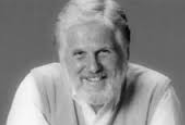 Genevieve Estelynn (Martin) Wimber. He demonstrated musical talent as a young boy and received his first saxaphone when he was six years-old. He was twelve when he and his mother moved to California, and it was just three years later when he made his first professional appearance as a musician. In 1955, Wimber met his future wife, Carol, a member of The Paramours, her prom band. The couple was married seven months later. The Paramours would work the Las Vegas circuit for the next five years. Wimber (as Johnny Wimber) played keyboards. Wimber also was involved in the formation of the popular band The Righteous Brothers (Jackson 2005:134). The Wimbers went through a period of marital separation but then remarried in a Roman Catholic Church (Randles n.d.). They then became involved in a Friends Meeting (Holsteine 2006:3) and were finally “converted” simultaneously in Bible study led by lay evangelist Gunner Payne (Randles n.d.). At about that point, both Wimbers, who had participated in Bible study became more deeply involved. John Wimber lead several through the Friends Meeting, and his wife Carol established one in their home in Yorba Linda, California, a suburb of Anaheim (Randles n.d.).
Genevieve Estelynn (Martin) Wimber. He demonstrated musical talent as a young boy and received his first saxaphone when he was six years-old. He was twelve when he and his mother moved to California, and it was just three years later when he made his first professional appearance as a musician. In 1955, Wimber met his future wife, Carol, a member of The Paramours, her prom band. The couple was married seven months later. The Paramours would work the Las Vegas circuit for the next five years. Wimber (as Johnny Wimber) played keyboards. Wimber also was involved in the formation of the popular band The Righteous Brothers (Jackson 2005:134). The Wimbers went through a period of marital separation but then remarried in a Roman Catholic Church (Randles n.d.). They then became involved in a Friends Meeting (Holsteine 2006:3) and were finally “converted” simultaneously in Bible study led by lay evangelist Gunner Payne (Randles n.d.). At about that point, both Wimbers, who had participated in Bible study became more deeply involved. John Wimber lead several through the Friends Meeting, and his wife Carol established one in their home in Yorba Linda, California, a suburb of Anaheim (Randles n.d.).
At about this time, 1965-1967, John Wimber felt called to leave the music business (James 2009:2), enrolling in Azusa Pacific University to study the Bible (With Christ 2013:1). On his graduation in 1970, Wimber was “registered” (ordained) by the Society of Friends, joining the staff of the Yorba Linda Friends Meeting (With Christ 2013:1). His involvement with Bible studies grew. At one point he was leading eleven such groups, involving several hundred students (members) (Vineyard USA website 2012).
Wimber’s evangelism became uncomfortably intense within the Friends context, and, in 1974, the Wimbers and about forty of their supporters were asked to leave the Friends Meeting (Holstein 2006). By this time, the growth of Wimber’s Bible studies had caught the attention of others in the Southern California religious community, including a church growth professor at Fuller Theological Seminary, C. Peter Wagner (Jackson 2005:135).
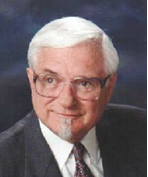 Wagner [Image at right] invited Wimber to help found the Fuller Institute for Church Growth at the seminary, where Wagner taught from 1975 through 1978. During that time, Wimber studied the factors contributing to church growth, not only in North America but also internationally. He concluded that charismatic phenomena constituted a critical factor. This was a paradigm shift both for Wimber and for Wagner, who also recognized the value of spiritual phenomena at this time (Jackson 2005:134, 135). In the meantime, Wimber continued to expand his Bible studies, to the point of incorporating as a church under the Calvary Chapel umbrella. He set out to apply what he had learned about church growth (Randles n.d.; Dager 1997).
Wagner [Image at right] invited Wimber to help found the Fuller Institute for Church Growth at the seminary, where Wagner taught from 1975 through 1978. During that time, Wimber studied the factors contributing to church growth, not only in North America but also internationally. He concluded that charismatic phenomena constituted a critical factor. This was a paradigm shift both for Wimber and for Wagner, who also recognized the value of spiritual phenomena at this time (Jackson 2005:134, 135). In the meantime, Wimber continued to expand his Bible studies, to the point of incorporating as a church under the Calvary Chapel umbrella. He set out to apply what he had learned about church growth (Randles n.d.; Dager 1997).
Wimber’s early efforts to develop charismatic phenomena in his church were not immediately successful, but after seven months, there was an instance of healing. A couple of years later, Lonnie Frisbee preached on Mother’s Day 1980, and the prayed-for outpouring of such experiences finally took place (Jackson 2005:134). Wimber and his church continued to place major emphasis on the experiential witness to the presence of the Holy Spirit as a sign of success, and Wimber’s church in Anaheim, California did indeed grow rapidly (Jackson 2005:134; VineyardUSA website n.d.).
A year or so earlier, Wimber had met another Bible study evangelist, Ken Gullicksen, at a Calvary Chapel pastors’ retreat. 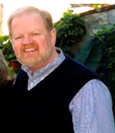 Gullicksen [Image at right] had been particularly successful with his Bible studies and with turning those study groups into congregations. Gullicksen himself said, “We were turning Bible studies into churches like unplanned parenthood.” Gullicksen worked at that point under the Calvary Chapel banner, though he called these churches “Vineyards.” There were about six such churches (Chandler 1992:281-90).
Gullicksen [Image at right] had been particularly successful with his Bible studies and with turning those study groups into congregations. Gullicksen himself said, “We were turning Bible studies into churches like unplanned parenthood.” Gullicksen worked at that point under the Calvary Chapel banner, though he called these churches “Vineyards.” There were about six such churches (Chandler 1992:281-90).
From 1982 until the course was cancelled in 1986, Wimber returned to Fuller on an adjunct basis to teach, with Wagner. They taught a controversial course titled “Signs, Wonders and Church Growth,” nicknamed by students “the miracle course” (Randles n.d.). Both Wagner and Wimber had clearly become fully convinced that such phenomena were essential factors in church growth.
Soon after starting to teach the Fuller class, Wimber, Gullicksen and several others reached a breaking point with Chuck Smith and Calvary Chapel. Wimber in particular, but others as well, felt strongly the need to emphasize “signs and wonders” as a means of attracting converts. Smith felt it was more important to continue an emphasis on Bible study. They agreed on an amicable separation, and Wimber joined Gullicksen, renaming his church The Vineyard Fellowship of Anaheim. Other former Calvary Chapel churches also joined the Vineyard group (Dager n.d.).
Faced with the responsibility of leading what was now a group of about fifteen churches, Gullicksen asked Wimber to take the leading role (Miller 2005:148). The group of churches expanded rapidly, and, in 1984, it expanded to Canada, with Vineyard Ministries International being formed (VineyardUSA website n.d.) A year later the Association of Vineyard Churches incorporated (Randles n.d.).
These events posed a problem for the Vineyard churches. Up to that point, they had functioned as a very loose association of independent churches. This was in keeping with the desire to avoid doctrine and expectations that might make potential members uncomfortable. Somewhat reluctantly, the leadership agreed that the Vineyard churches did, indeed, constitute a denomination (Factualworld n.d.).
Soon after, in 1986, Wimber wrote the book Power Evangelism, outlining the methods and beliefs of Vineyard movement. He proposed that Vineyard methods replace the Bible-based evangelism of other churches. Wimber contended that without “signs and wonders” to confirm their validity, these methods were largely ineffective (Dager 1997:9).
Also in 1986, Wimber had a heart attack, but recovered quickly, and by 1988, he was in consultation with the prophetic figures of the Kansas City Fellowship. That group, heavily influenced by the Latter Rain revival of the 1940s, included Paul Cain (who had been involved with the Latter Rain movement early in his career), Bill Hamon (also formerly involved with Latter Rain), Rick Joyner, Bob Jones, Mike Bickle, Lou Engle and several others (Jackson 2005:138). These men espoused the “five-fold ministry” concept popularized by the Latter Rain movement. Five-fold ministry is a belief that the five offices mentioned in Ephesians 4:11 (apostle, prophet, evangelist pastor and teacher) remain active and valid in the contemporary church. These men styled themselves as apostles and prophets. They were also active in Latter Rain dominionism and Manifest Sons of God (Joel’s Army) teachings (Let Us Reason 2009:5 ). The Kansas City Christian Fellowship, of which Mike Bickle was pastor, renamed itself the Kansas City Vineyard, and for some time this group was said to have been very influential with Wimber himself and with other leaders of the Vineyard movement. Wimber strongly recommended these men to others in the Vineyard movement (Jackson 2005:137).
However, by 1991, along with his colleague C. Peter Wagner, Wimber became disillusioned with the Kansas City group, reportedly because of failed prophecies and morality questions involving Bob Jones (Jackson 2005:137). Wimber broke off the relationship and the Kansas City church resumed its former name (later IHOP, International House of Prayer), but Latter Rain influences clearly continued in Wimber’s thinking. At least one source described Wimber’s teaching as “clearly dominionist,” and he is mentioned repeatedly in articles on Joel’s Army, as is his colleague C. Peter Wagner (Randles nd:1; Gilley 2004:5).
In 1994, the Vineyard movement faced what probably was its greatest challenge up to that time. In January of that year, John Arnott and his wife Carol, pastors of the Toronto Airport Vineyard church, invited Pastor Randy Clark of St. Louis to preach in their church. Clark, who had been heavily influenced by Rodney Howard-Brown, a South African evangelist known for “Holy Laughter” revivals, preached in early January to a group of about 150, many of whom broke out into uncontrollable laughter, fell on the floor and demonstrated other charismatic phenomena (Riss 1996:1).
Soon a major revival broke out, involving thousands of people from around the world and major, continuing media coverage. Over the period of about a year, the charismatic phenomena became increasingly bizarre, including people making animal sounds. In 1995, Wimber visited Toronto, observed the phenomena, and then, with the backing of his leadership, “released” the Toronto group from the Vineyard flock, though he never directly repudiated the revival. The move was controversial, even within the Vineyard community (Jackson 2005:138).
During this period, roughly 1993 through 1995, Wimber was diagnosed with cancer and also suffered a stroke; clearly his health was beginning to fail. In 1997, Wimber named one of his leadership team, Todd Hunter, as National Coordinator of The Association of Vineyard Churches. The denomination continued to grow rapidly during this time, both through emphasizing church planting and through receiving churches that wished to join (Miller 2005: 151, 152).
Wimber had earlier established a system of national governance, initially installing four regional overseers in the US, and making those overseers, the national director and two other pastors a national governing board (Factualworld 2015:2). Nonetheless, when John Wimber died in November 1997of a massive brain hemorrhage, his absence left a major gap in the Vineyard leadership. The board named Todd Hunter National Director (Miller 2005:151, 152).
Hunter made two major moves to revitalize the church. The first move was to abolish all middle management leaving only area pastoral coordinators, themselves active pastors. Hunter’s intention was to release what he called a “charismatic moment” that would allow individual pastors a stronger voice that would radicalize the Vineyard (Miller 2005:152). Hunter’s second move was to follow Wimber’s intention to keep the church culturally relevant. He wanted to create a movement that would be inviting to GenXers and Millenials, essentially a church within a church (Miller 2005:141). On both counts he appeared to be largely ineffective. He resigned in May of 2000, and went on to found Church for the Sake of Others (C4SO) as a diocese of the Anglican Church in North America (Miller 2005:155).
The board chose Bert Waggoner, a pastor from Sugarland, Texas to replace Hunter. Waggoner’s eleven-year tenure as National Director largely involved keeping the Vineyard boat stable and on course, focusing primarily on church planting and evangelism (Factualworld 2015:1). In 2011, for example, he led a study that rewrote the Vineyard’s statement of core values (World Heritage 2014:3).
DOCTRINES/BELIEFS
The Vineyard churches are considered to be part of a “third wave” of charismatic expression, the first being the Azusa Street revival of the 1940s and the second the charismatic movement of the 1950s and 1960s. The term was coined by Wimber’s associate at Fuller Seminary, C. Peter Wagner (Jackson 2004:133). Wagner had first used the term “post denominationalism” to describe the phenomenon. Wimber described his theological position as the “radical middle” after a book by Bill Jackson called The Quest for the Radical Middle. The concept reflects an attempt to find a middle way between Pentecostal and Charismatic traditions (Jackson 1999).
Through much of its history, The Association of Vineyard Churches has attempted to avoid establishing formal doctrine. This does not mean that there were no understood and commonly held positions on theological issues, but rather that the denomination was very strongly oriented toward growth and reaching a wide range of people. Many in the movement felt strongly that formal doctrines and rituals would put off exactly the people they were attempting to reach. Further, John Wimber’s teaching constituted a basic doctrine and many felt nothing more was needed.
In fact, at a Vineyard pastors conference in 1992, Wimber taught on ten areas of ministry that he considered essential to any Vineyard church. He called these areas the Vineyard Genetic Code because they were the factors that he felt define the Vineyard movement. These include:
Clear, accurate, Biblical teaching.
Contemporary worship in the freedom of the Holy Spirit.
The gifts of the Holy Spirit in operation.
An active small group ministry.
Ministry to the poor, widows, orphans and those who are broken.
Physical healing with emphasis on signs and wonders as seen in the book of Acts.
A commitment to missions – church planting at home and world missions abroad.
Unity within the whole body of Christ; a relationship with other local churches.
Evangelistic outreach.
Equipping the saints in areas such as discipleship, ministry, serving, giving, finances, family, etc. (Williams 2005:180)
The Vineyard Genetic Code identifies the Vineyard Churches in the place Wimber stated that he wished them to be, the “radical middle” between Pentecostal and charismatic churches (Jackson 2004:135). In addition to this statement, Wimber was widely quoted as saying that Vineyard Churches should make room for the Holy Spirit to do unexpected things (Williams 2005:181).
In 1994, however, Wimber and the church’s leadership determined that it was necessary to publish a Statement of Faith for the rapidly growing and highly diverse movement. In announcing the Statement, Wimber indicated that it had been under construction for ten years, since the beginning of the movement (Williams 1994:180). The Statement itself is deliberately a non-controversial statement of widely held evangelical beliefs (Williams 2004:180), though the wording strongly reflects a Kingdom Theology, the belief that the Kingdom of God exists here and now, though it is not yet fully realized. The first two articles (of twelve) begin with the words “God the King,” and several others include similar wording (Vineyard USA website 2012). Since Kingdom Theology is a position widely held among Pentecostal, and particularly among Charismatic churches, this is not generally a divisive stance (Jackson 2005:134).
By 2004, there was a feeling that this Statement of Faith required clarification in several areas, and in 2004, Berten Waggoner, the third National Director, issued a series of clarifications that did not significantly change the meanings contained in the original document, but made clearer the meanings of some phrasing (Williams 2004:180). In 2011, again under the leadership of Waggoner, several committees rewrote the Statement of Faith to make it shorter and simpler. The new Statement consists of just five points, but does not change the basic Kingdom Theology approach (Vineyard USA website 2012).
A key Vineyard value is a “continuationist” theological stance, one which contends that the gifts of the Holy Spirit [healing, exorcism, glossolalia (speaking and singing in tongues)} continue to be just as available today as they were in the time of the apostles (Dagger n.d. :4). Another important element of Vineyard belief is dominionism, the belief that this country and the world should be ruled entirely by Christians and particularly by conservative Christians (InPlainSite n.d.). This belief appears to be more traditional than documentary and is harder to track since it appears in no available Vineyard statement. It may come from Wimber’s association with Wagner, who has been called Mr. Joel’s Army (a concept derived from the Manifest Sons of God theology of the Latter Rain revival) and who has written extensively about spiritual warfare. Alternatively, it could be an artifact of Wimber’s association with the Kansas City prophets, who were heavily influenced by the Latter Rain revival (Holstein 2013:1, 2, 3).
A recent change in doctrine concerns the role of women in leadership positions. Wimber held a “complementarian” position, that is, that men and women had different but complementary roles. Women, starting with Wimber’s wife Carol, had always been involved with the leadership of the Vineyard, but according to this view, only men could be senior pastors. Church policy now allows for ordained women (Loren 2007: 2), but since Vineyard pastors are ordained by the local church rather than by the denomination, the decision to ordain women is up to each local church (Williams 2005:182).
RITUALS/PRACTICES
The primary ritual of Vineyard churches is the Sunday morning worship service. [Image at right] Since The Association of Vineyard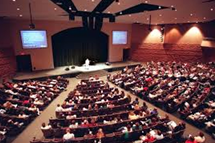 Churches is a network of largely independent churches, the form of Sunday services may vary, sometimes considerably (Miller 2005:143, 146, 161. Williams 2005:163). Typically, Vineyard services begin with a period of worship and praise, consisting of singing of contemporary music with words that are addressed to God. This music often is music written either within or specifically for the Vineyard, though it is often used elsewhere today. Observers have noted that most of this music has a distinctive sound, and the Vinyard has its own label, Vineyard Music. There is usually a group of several musicians leading the singing, and lyrics are projected on large screens. This period may last up to half an hour or more. During this time, the congregation is free to sit, stand or move around. Often there are drinks available and these may be carried Miller 2005:143).
Churches is a network of largely independent churches, the form of Sunday services may vary, sometimes considerably (Miller 2005:143, 146, 161. Williams 2005:163). Typically, Vineyard services begin with a period of worship and praise, consisting of singing of contemporary music with words that are addressed to God. This music often is music written either within or specifically for the Vineyard, though it is often used elsewhere today. Observers have noted that most of this music has a distinctive sound, and the Vinyard has its own label, Vineyard Music. There is usually a group of several musicians leading the singing, and lyrics are projected on large screens. This period may last up to half an hour or more. During this time, the congregation is free to sit, stand or move around. Often there are drinks available and these may be carried Miller 2005:143).
The musical worship period [Image at right] is usually followed by a word (a short homily or sermon) on a current question or Bible 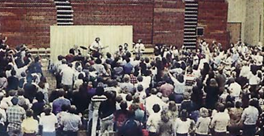 passage. This is typically delivered in a relatively conversational way, eschewing the dramatic rhetoric often associated with Pentecostal, fundamentalist or charismatic preaching (Miller 2005:143). Dress for both worshippers and worship leaders is informal. John Wimber, the movement’s founder, frequently delivered the word sitting on a high musician’s stool and wearing a Hawaiian shirt (Loren 2007:1).
passage. This is typically delivered in a relatively conversational way, eschewing the dramatic rhetoric often associated with Pentecostal, fundamentalist or charismatic preaching (Miller 2005:143). Dress for both worshippers and worship leaders is informal. John Wimber, the movement’s founder, frequently delivered the word sitting on a high musician’s stool and wearing a Hawaiian shirt (Loren 2007:1).
Following the word is ministry time. In churches following the Vineyard’s original format, or the more revival type format inherited from the Kansas City Prophets period, the ministry time may feature “signs and wonders” reflecting the active presence of the Holy Spirit within the service. In more “seeker sensitive” congregations, overt manifestations of the spirit may be confined to other venues (Williams 2005:168, 176).
A secondary tradition (perhaps not properly called a ritual but of almost equal importance), is the small-group Bible study which take place usually on weeknights, but may be scheduled at any mutually convenient time. Much of the Vineyard’s caring and healing ministry, as well as evangelism and planning for outreach and social ministry, takes place within these groups, emphasizing the Vineyard’s commitment to the concept of the priesthood of all believers by encouraging all members toward a ministry of some type (Williams 2005:175, 176, 182, 185).
Vineyard theology encourages development of a very personal relationship with God, and there are reports of members having “date nights” with Jesus; cooking a special meal, setting an extra place at the table, and carrying on an intimate conversation (Rodgers 2012:3).
ORGANIZATION/LEADERSHIP
Donald Miller (2005:161) wrote perceptively that “The Vineyard…represents a different genre of religious organizations…. The Vineyard is part of a ‘new paradigm of independent churches and church movements that are deeply suspicious of ….denominations, ….These new churches prefer to identify themselves as ‘movements’ or networks of affiliated churches. Some of them….proclaim they are part of a postdenominational era….” In practice, Vineyard churches seem to divide into three types. The mainstream type continues the Kingdom values that the movement began with. A second type follows the Latter Rain prophetic and revival values received from the Vineyard’s association with the Kansas City prophets. A third type eschews spiritual manifestations within public services, seeking to be “seeker sensitive,” avoiding activities that might scare or confuse.
The Association of Vineyard Churches has about 550 churches in the U.S. and another thousand elsewhere in the world.  Combined attendance in the U.S. is reportedly about 80,000 to 90,000 (VineyardUSA 2012; Miller 2005:141). The national office is still listed as Stafford, Texas, where it was located when Berton Waggoner became national director. The leadership consists of a National Director, Vice President, National Coordinator, and fourteen other members of the Executive Team. There are also sixteen regional leaders, each of whom is responsible for several area leaders, who in turn are responsible for supporting the pastors of several churches. All of these individuals are themselves active pastors of churches (VineyardUSA website 2012). National leadership notwithstanding, Vineyard churches remain a relational network. The responsibilities of regional and area leaders are largely communication, support, and mentoring rather than supervision. National policy may be made at national conferences, though these are largely inspirational (Miller 2005:182, 183, 184).
Combined attendance in the U.S. is reportedly about 80,000 to 90,000 (VineyardUSA 2012; Miller 2005:141). The national office is still listed as Stafford, Texas, where it was located when Berton Waggoner became national director. The leadership consists of a National Director, Vice President, National Coordinator, and fourteen other members of the Executive Team. There are also sixteen regional leaders, each of whom is responsible for several area leaders, who in turn are responsible for supporting the pastors of several churches. All of these individuals are themselves active pastors of churches (VineyardUSA website 2012). National leadership notwithstanding, Vineyard churches remain a relational network. The responsibilities of regional and area leaders are largely communication, support, and mentoring rather than supervision. National policy may be made at national conferences, though these are largely inspirational (Miller 2005:182, 183, 184).
ISSUES/CHALLENGES
Vineyard churches have been widely and sometimes viciously criticized over the years. At least some of the criticism can be traced to competing denominations reacting to what is perceived as “sheep stealing” (the targeted attraction of one church’s members by another) (Miller 2005:162).
Probably the most serious challenges come from very conservative religious sources that criticize the Vineyard movement on several counts. Foremost among these is the accusation that Vineyard theology is unbiblical and depends on extrabiblical revelation, experience and prophecy (Jackson 2005:137; Randles n.d.:5, 6; Holstein 2006:5). This is an interesting challenge. On the one hand, the Vineyard simply did not have an official theology for many years, and when one was published, it was thoroughly backed by Biblical citation, and one of its points was the requirement for a solid Biblical foundation. Further, as noted above, the Statement of Faith is deliberately non-controversial, and Kingdom theology is not at all uncommon among the sources of criticism (Williams 2005:173). On the other hand, Wimber himself made statements such as “God is bigger than his word” and that God should not be limited by scripture. He further suggested that “words of knowledge” (a reference to extrabiblical revelation) can be considered very important, perhaps equal to Biblical revelation (Dager 1997:2).
Also, the Vineyard’s “signs and wonders” ministry raises the old theological split between continuationists (who believe that gifts of the spirit continue to be available) and the cessationists (who contend that such gifts ended with the end of the apostolic age) (Randles nd: 2; Holstein 2006:2). Wimber clearly supported the concept of extrabiblical revelation very early on, but involvement with C. Peter Wagner and later with the Kansas City prophets undoubtedly strengthened this view. The source of these views is unclear since Wimber, like Wagner, had a policy of not responding to criticism (both did so eventually, but their responses were not comprehensive) Jackson 2005:137).
Another criticism, specifically from fundamentalist heresy hunters, is the refusal of the Vineyard to include the word “inerrant” in its discussion of the role of the Bible. This is essentially semantic, since the Vineyard statement of faith describes the Bible as being “without error in its original manuscripts” (CRI Statement 2009:2; VineyardUSA 2012).
Finally, there is the question of who the Vineyard is reaching. There is no real question that Vineyard congregations are, like their pastors, overwhelmingly white, largely middle class and middle age. They are the culture to which Wimber sought to be relevant. But that generation is aging, and Gen-X and Millennials, in the words of Todd Hunter, find the sound of Vineyard music just as ancient as Bach did to Boomers. They approach the idea of religion in a distinctly post-modern way (where Boomers are specifically modern in their outlook) (Miller 2005:150).
Whether the Vineyard will find a way to be culturally relevant to these new generations may be, as Hunter suggested, the major challenge to continued Vineyard evangelism and church growth. Also needed will be a way to become more diverse to remain culturally relevant as the culture becomes more diverse (Miller 2005:150. Williams 2005:186). As one Vineyard pastor summed up the challenge, “We’re trying to preserve the heart that John gave us,” he says. “If we can have that heart continue generation after generation, we’ll be doing well” (Loren 2007).
IMAGES
Image #1: Photograph of John Wimber, founder of the Association of Vineyard Churches.
Image #2: Photograph of C. Peter Wagner who invited Wimber to help found the Fuller Institute for Church Growth.
Image #3: Photograph of Kenn Gullicksen who joined with John Wimber in forming The Vineyard Fellowship of Anaheim.
Image #4: Photograph of a Vineyard worship service.
Image #5: Photograph of Vineyard musical worship period.
Image #6: The Association of Vineyard Churches logo.
REFERENCES
Chandler, Russell. 1992. Racing Toward 2001. Grand Rapids, MI: Zondervan.
Chapel on the Vine. 2015. “Our History.” Accessed from http://chapelonthevine.org/pages/ourhistory.aspy on 24 February 2015.
Dager, Albert James. 1997. “John Wimber and the Vineyard.” Accessed from http://www.rapidnet.com/~jbeard/bdm/exposes/wimber/john.htm on 16 February 2015.
Factualworld. 2015. “Vineyard Movement.” Accessed from http://www.factualworld.com/article/vineyard_movement on 4 January 20155.
Gilley, Gary. 2004. “Vineyard Movement and ‘Christian’ Charismania.” Biblical Discernment Ministries. Accessed from http://rapidnet.com/~jbeard/bdm/psychology/vine/vineyard on 4 January 2015.
Holstein, Joanne. 2006. “Vineyard Church.” Becker Bible Studies Library. Accessed from http://guidedbiblestudies.com/library/vineyard_church.htm on 4 January 2015.
Jackson, Bill. 2005. “A Short History of the Association of Vineyard Churches.” Pp. 132-40 in Church, Identity and Change, edited by David A. Roozen and James R. Nieman. Grand Rapids, MI: Erdmans.
James, Christopher B. (2009) Jesus Dust: Meet John the Miracle Worker, The Story and Legacy of John Wimber.” Accessed from http://www.jesusdust.com/2009/02/meet. John-the-miracle-worker.html on 16 February 2015.
Loren, Julia C. (2007. “The Legacy of a Humble Hero.” Accessed from http://www.charismag.com/site-archives/508.features on 1 April 2015.
Miller, Donald E. 2005. Routinizing Charisma: The Vineyard Christian Fellowship.” Pp. 141-162 in Church, Identity and Change, edited by David A. Roozen and James R. Nieman. Grand Rapids, MI: Erdmans.
Randles, Bill. n.d. “The Roots: John Wimber and the Vineyard.” Accessed from http:www.inplainsite.org/vineyard_johnwimber.html on 4 January 2015.
Regent University. n.d. “John Wimber Timeline.” Regent University Library John Wimber Collection. Accessed from http://www.regent.edu/lib/special_collections/wimber-files on 20 February 2015.
Riss, Richard M. (1996) A History of Revival 1992-1995, The Vineyard Churches.” Accessed from http://grmi.org/richardriss/history/vineyard.html on 27 February 2015.
Rodgers, Paul. 2012. “Seeing and Believing.” Accessed from http;//www.newyorker.com/magazine/2012/04/02/seeing-and-believing on 27 February 2015.
Vineyard Christian Fellowship website. n.d. “Time-Line of the Life of John Wimber and the Vineyard.” Accessed from http://www.ourvineyard.org/Time on 25 February 2015.
Williams, Don. 2005. “Theological Perspectives on The Vineyard Christian Fellowship.” Pp. 163–87 in Church, Identity and Change, edited by David Roozen and James Nieman. Grand Rapids, MI: Erdmans.
With Christ. 2013. “Vineyard Christian Fellowship – an Expose.” Accessed from http://withchrist.org/vineyard on 5 January 2015.
World Heritage Encyclopedia. 2014 “Association of Vineyard Churches.” Accessed from http://www.worldheritage.org/article/WHEBN0000336482/Association%20of%20Vineyard%20Churches on 14 February 2015.
Post Date:
4 September 2016
